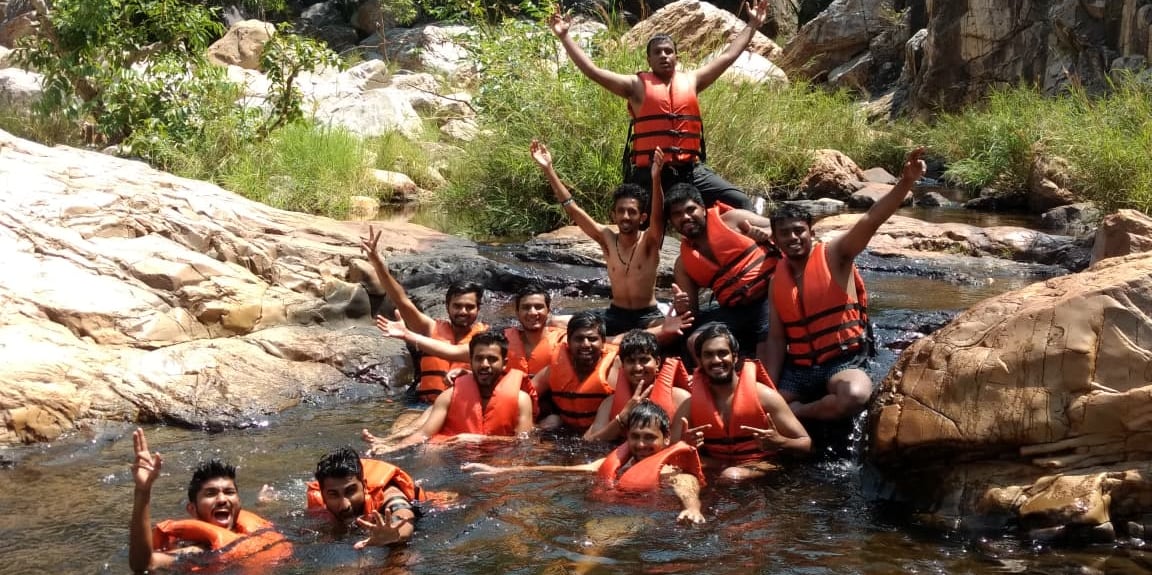Nagalapuram Trek: Chickens, Talking Trees, and a Midnight Monkey Chase
01 July, 2025
Sunil Ramareddy
Back in 2015, when I was in my third year of engineering, some of my classmates went to a place called Nagalapuram for a trek. The photos and their stories made me feel like the forest itself was calling my name. One of the trekkers was my good friend Sachin, who also happened to be my travel buddy to college every day. We must have discussed this trek a hundred times during those rides, and with each conversation, my curiosity grew.
Nagalapuram, tucked away in the Eastern Ghats of Andhra Pradesh, is a paradise for trekkers. It’s famous for its crystal-clear streams, natural pools, and scenic waterfalls hidden deep inside thick forests. The best part? It’s still less commercialized than many trekking spots, so you feel like you’re walking in a secret world.
Weeks later, I pitched the idea to my friends, and soon 13 adventurous souls signed up — including two juniors and my school friends Manish and Vineeth. We booked a Tempo Traveller through Punith (the unofficial trip planner for all our adventures) and set off at night, reaching early morning so we could start trekking before the sun got too harsh. Since Sachin had been there before, he arranged for our guide — Raju, a local expert who not only knew the forest like the back of his hand but could also cook for us.
The plan: 7 km trek one way, stop at pools along the route, camp overnight, cook dinner, relax, and return the next day. We rented two huge tents from Bangalore and carried life jackets for safety.
When we met Raju in the morning, we realized we needed utensils and ingredients. He rented us cooking pots from his home, and we shopped for spices, vegetables, and — surprise — two live chickens for our dinner biryani. Everyone took turns carrying gear: tents, backpacks, utensils… and yes, the chickens. One of them was in the energetic hands of Dhanush, who swung his arms like a windmill while walking through thorny forest paths. By the time we reached our first pool, that poor chicken had… well, let’s just say it had gone to the great poultry farm in the sky. Dhanush claims it “died of fright,” but I suspect his high-speed chicken shaker technique had something to do with it.
We began our trek walking across an empty reservoir, the March sun already blazing overhead. Entering the thick forest patch was like stepping into another world — tall trees filtering the sunlight into golden stripes, birds calling from somewhere unseen, and the sound of a distant stream leading us forward.
The stream itself was magical — clear, cold water running over smooth stones shaped by years of tumbling in the current. Our first stop was a deep, inviting pool. For many of us, it was the first time jumping from a 15-foot rock into water, and the real challenge was convincing Vineeth to take the leap. After swimming, the sun dried us instantly, and the heat quickly reminded us we still had a long way to go.
By late evening, we reached the top — greeted by yet another pool, complete with a natural rock slide.
As night fell, something strange happened — the temperature rose. This was because large rocks absorb heat slowly during the day and release it slowly at night, much like concrete in cities, creating an urban heat island effect. The rocks around us were radiating all the warmth they had stored during the day.
We were thirsty, but the stream water was far below. The only option? Walk 400 meters through pitch-dark forest to a small waterfall. No one wanted to go first — including me, the self-declared President of People Who Are Afraid of the Dark. So, we made four teams to fetch water in turns. My team was last: me, Dhanush, Vineeth, and Manish.
Halfway through, we heard rustling in the trees. We froze. Our hearts raced as we aimed our torch upwards, expecting glowing eyes or a ghostly figure. After a long, suspenseful moment, the culprit revealed itself — a mischievous monkey following us! We laughed, but none of us wanted to be the last one walking, so our “casual stroll” turned into a brisk march.
The forest was so dense that the tree trunks seemed alive, reminding me of The Chronicles of Narnia, where trees had faces and spoke to travelers.
Dinner, Dog, and “Neer Kudithiya”
Back at camp, the smell of chicken biryani filled the air. I swear no biryani has ever tasted better — hunger makes every bite feel like magic. That night, we pitched the tents but didn’t sleep in them because of the heat. Instead, we lay on the ground, staring at the stars and the steep hill above us.
One person, however, couldn’t sleep — Vineeth. Every so often, he’d wake someone up asking “Neer Kudithiya?” (“Do you want water?”), including poor Punith who was sleeping peacefully. To this day, we still roast him with that line.
Early in the morning, long before the rest of the world had woken up, I was stirred by a sharp, rhythmic “tock… tock… tock.”
In my early days of birdwatching, every call was a mystery waiting to be solved. Back then, I didn’t have fancy binoculars or thick field guides memorised. I only had my curiosity, a small notebook, and the habit of standing still for minutes just to catch a glimpse of whatever was making the sound.
That morning, peering through the soft golden light, I spotted it — a small bird, barely twice the size of a sparrow, sitting proudly on a branch. The first thing that caught my eye was its head — splashed with a bright red forehead that seemed to glow in the sun. Below it, a neat yellow patch on its throat stood out like a little scarf. Its body shimmered in shades of green, blending with the leaves until it almost vanished when it stayed still.
The “tock… tock… tock” continued, steady and sure, like a metalworker tapping away at his craft. Later, I learned this was the Coppersmith Barbet — named because its call perfectly mimics the sound of a copper metalworker’s hammer.
That moment wasn’t just about identifying a bird. It was my first lesson in listening to nature. Sometimes, the forest doesn’t just show you its wonders — it calls you to notice them.
While doing my headcount, I noticed two people missing — junior Sinchu and Sachin. Given the rocky terrain and my Anaconda-inspired imagination, I feared the worst. Turns out, Sinchu was somehow sleeping inside the sweltering tent, and Sachin was lying under a tree 10 meters away, sleeping like a baby.
We saw no snakes, no scary animals (except that monkey), and eventually made our way back to the Tempo Traveller for the ride home — tired, happy, and carrying enough stories to last for years.


Wildlife Conservation Group
Adavi Field Station (AFS), Ontemarana doddi village, Ragihalli post, Anekal taluk, Bengaluru - 560083.
(+91) 9483996832, 9008261066
Copyright © 2023 Wildlife Conservation Group.
All rights reserved.


Contact Us







